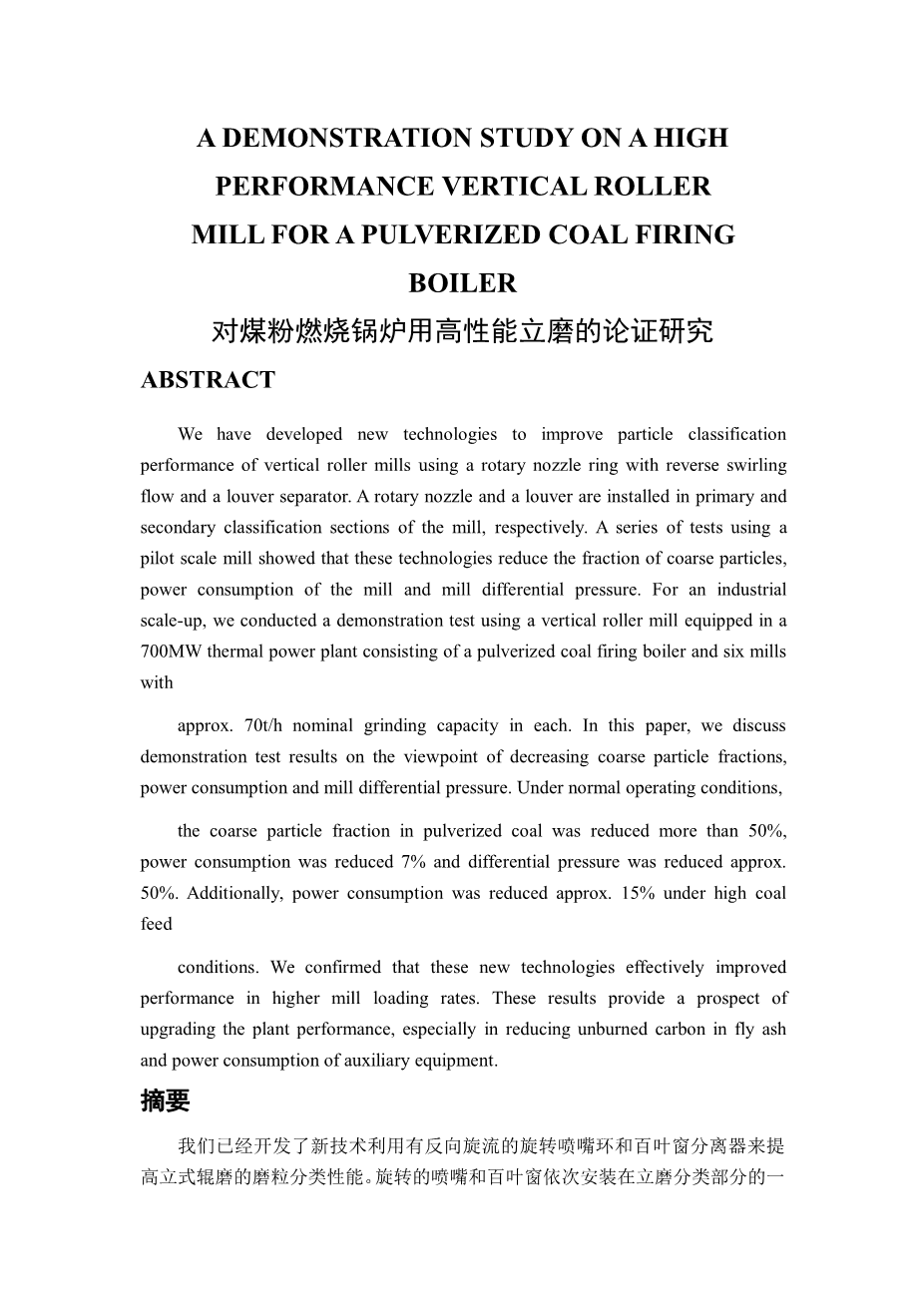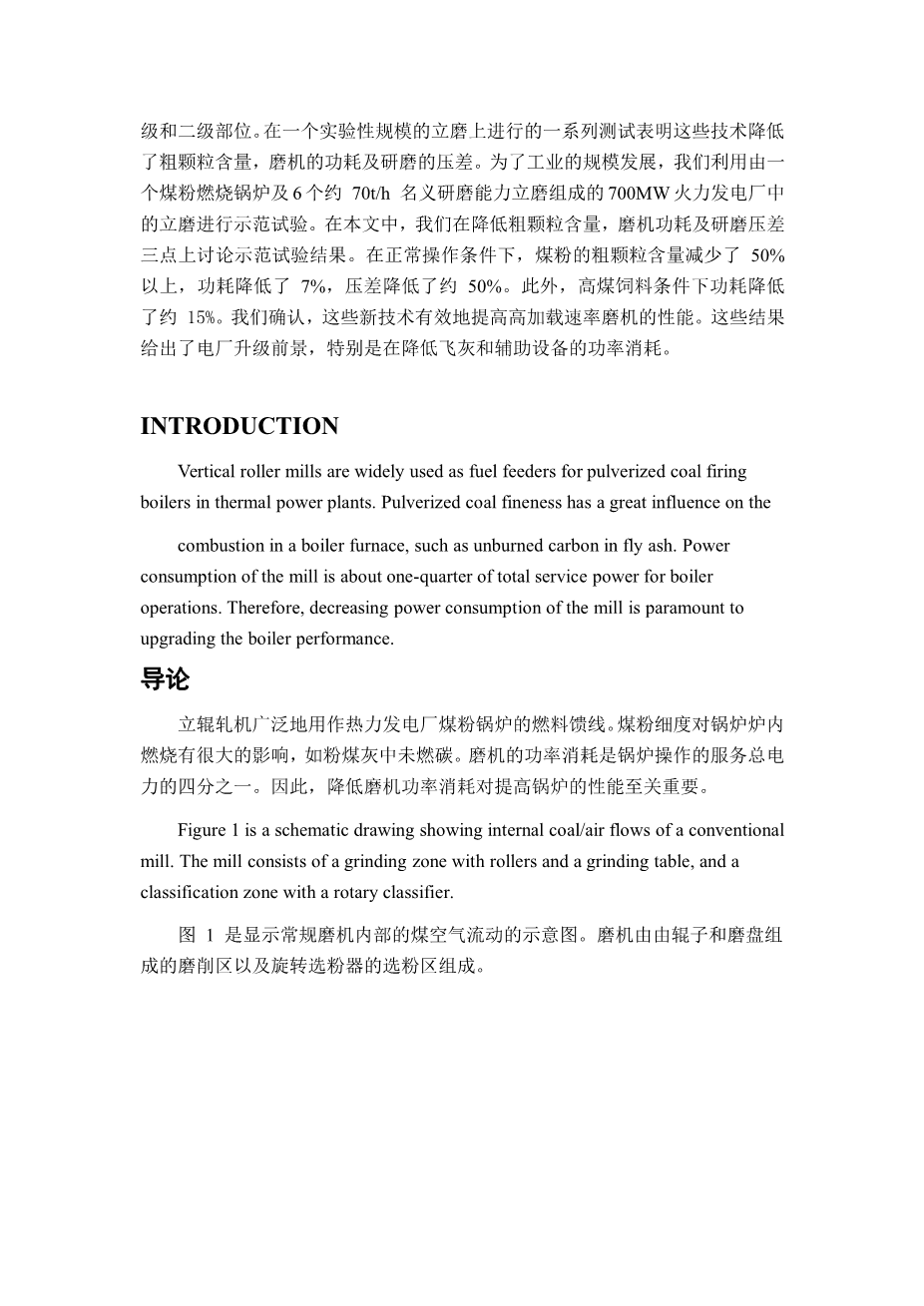立磨生产线磨辊轴部件设计与有限元分析外文翻译资料
2022-09-08 12:44:57
Proceedings of the ASME 2011 Power Conference
POWER2011
July 12-14, 2011, Denver, Colorado, USA
POWER2011-55365
A DEMONSTRATION STUDY ON A HIGH PERFORMANCE VERTICAL ROLLER MILL FOR A PULVERIZED COAL FIRING BOILER
Yutaka Takeno Babcock-Hitachi K.K. Kure Research Lab. Kure, Hiroshima, Japan
Hiroaki Kanemoto Babcock-Hitachi K.K. Boiler Engineering Dept. Kure, Hiroshima, Japan
Hideo Mitsui Babcock-Hitachi K.K. Boiler Engineering Dept. Kure, Hiroshima, Japan
ABSTRACT
We have developed new technologies to improve particle classification performance of vertical roller mills using a rotary nozzle ring with reverse swirling flow and a louver separator1. A rotary nozzle and a louver are installed in primary and secondary classification sections of the mill, respectively. A series of tests using a pilot scale mill showed that these technologies reduce the fraction of coarse particles, power
consumption of the mill and mill differential pressure. For an industrial scale-up, we conducted a demonstration test using a vertical roller mill equipped in a 700MW thermal power plant consisting of a pulverized coal firing boiler and six mills with approx. 70t/h nominal grinding capacity in each. In this paper, we discuss demonstration test results on the viewpoint of decreasing coarse particle fractions, power consumption and mill differential pressure. Under normal operating conditions, the coarse particle fraction in pulverized coal was reduced more than 50%, power consumption was reduced 7% and differential pressure was reduced approx. 50%. Additionally, power consumption was reduced approx. 15% under high coal feed conditions. We confirmed that these new technologies effectively improved performance in higher mill loading rates. These results provide a prospect of upgrading the plant
Figure 1 is a schematic drawing showing internal coal/air flows of a conventional mill. The mill consists of a grinding zone with rollers and a grinding table, and a classification zone with a rotary classifier.
The grinding procedure is described below. Raw coal is introduced from the top center of the mill into the center of the rotating grinding table that moves the coal outward by centrifugal action. It is ground by grinding rollers running against the table. The ground coal passes over the rim of the table and is swept up and dried by hot air spouting from a nozzle ring that is placed around the table (A). The powder bed above the nozzle ring is either a spouted bed or a fluidized bed (B). Large particles in the upstream are gravitationally separated from the stream and fall back to the grinding zone, while small particles are conveyed to the rotating classifier (primary classification (C)). The solid-gas two-phase flow that reaches the classifier is swirled by the rotary classifier. Coarse particles are separated from the two-phase flow by the centrifugal force and fall down to the grinding zone, while fine
Raw coal Pulverized coal
Pulverized coal
Raw coal
performance, especially in reducing unburned carbon in fly ash
and power consumption of auxiliary equipment.
INTRODUCTION
Vertical roller mills are widely used as fuel feeders for pulverized coal firing boilers in thermal power plants.
D Rotary
classifier
C
B
D Secondary classification
(Centrifugal)
C Primary classification
(Gravity)
Pulverized coal fineness has a great influence on the
combustion in a boiler furnace, such as unburned carbon in fly
Roller
Grinding
GGGG
RoRoRoRo
No zzle ring
A Grinding zone
NNNN
B Spouted or fluid ized bed
ash. Power consumption of the mill is about one-quarter of total
service power for boiler operations. Therefore, decreasing power consumption of the mill is paramount to upgrading the
boiler performance.
table
A Jet
Hot air
Fig.1 Schematic and internal coal/air flows of a vertical mill
1 Copyright copy; 2011 by ASME
particles pass through the classifier and are transported to burners of the boiler furnace via individual fuel pipes (secondary classification (D)).
Classification performance has a great influence on fineness of pulverized coal 3 and power consumption 4,5 in the closed circuit. For fine particle size distribution, it is important
to remove coarse particles from discharged powder. This can be achieved by improvement of classification performance that
Partic le flow
Air je t direc tion
Table ro tating direction
PPPP wwww
AAAA
P artic le flow
Air je t direc tion
Table ro ta ting direction
PPPParararar wwww
AAAA
separates coarse particles and discharges fine particles through
the classifier. To reduce power consumption, it is important not to over-grind through needless recirculation of fine particles in the circuit. This can also be achieved by sharp classification.
We have developed new technologies to improve particle classification performance of the vertical roller mill at primary and secondary classification sections respectively: a rotary nozzle ring with a reverse swirling flow and a louver separator1.In this paper, we discuss the results of a demonstration test conducted for industrial scale-up. The demonstration plant had a rated capacity of 700MW and six mills with an approx. 70t/h nominal grinding capacity.
Developed technologies were installed in one mill. Performance of the modified mill was compared with that of others.
剩余内容已隐藏,支付完成后下载完整资料


英语原文共 23 页,剩余内容已隐藏,支付完成后下载完整资料
资料编号:[146343],资料为PDF文档或Word文档,PDF文档可免费转换为Word




